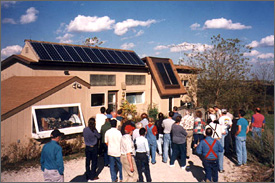EERE Network News
EERE's newsletter, the EERE Network News, covers national and international energy efficiency and renewable energy news and events, as well as new EERE Web sites and energy facts. If you would like this newsletter emailed to you weekly, subscribe here.
September 17, 2008
News and Events
- DOE to Invest $4.4 Million in Six Biofuels Research Projects
- DOE and Ad Council Launch Energy Efficiency Campaigns for Kids
- GM Celebrates its 100 Birthday by Unveiling the Chevrolet Volt
- Intercontinental Flight Demonstrates Fuel-Saving Technologies
- National Solar Tour Comes to All But Four States in October
- Report: $100 Billion Could Yield 2 Million Clean Energy Jobs
Energy Connections
- Hurricane Ike Spikes Gasoline Prices as Oil Prices Fall
News and Events
DOE to Invest $4.4 Million in Six Biofuels Research Projects
DOE announced on September 10 that it has selected six university-led advanced biofuels projects to receive up to $4.4 million, subject to annual appropriations. The awardees—Georgia Tech Research Corporation, the University of Georgia, the University of Maine, Montana State University, Steven's Institute of Technology in New Jersey, and the University of Toledo in Ohio—will all receive funding to conduct research and development of cost-effective, environmentally friendly biomass conversion technologies for turning non-food feedstocks into advanced biofuels. Combined with a university cost share of 20%, more than $5.7 million is slated for investment in these projects.
Most of the projects will involve microbiology, including the University of Georgia and Montana State University projects, which are both focused on producing oils from algae. The University of Georgia will investigate the use of poultry litter to produce low-cost nutrients for algae, while Montana State, in partnership with Utah State University, will research the oil content, growth, and oil production of algae cultures in open ponds. Applying microbiology to biomass conversion, the University of Maine will study the use of bacteria to create biofuels from regionally available feedstocks, such as seaweed sludge and paper mill waste streams, while the University of Toledo will attempt to use pellets containing enzymes to efficiently convert cellulosic biomass into ethanol.
In contrast, Georgia Tech Research Corporation and Steven's Institute of Technology are both investigating the gasification of biomass. Georgia Tech will evaluate two experimental gasifiers run on forest residues, while Steven's Institute will test a novel microchannel reactor that gasifies pyrolysis oil, a petroleum-like oil produced by exposing biomass sources such as wood chips to high temperatures in the absence of oxygen. Gasified biomass can be used as a gaseous fuel or passed through a catalyst to produce a wide range of liquid fuels and chemicals. See the DOE press release.
DOE and Ad Council Launch Energy Efficiency Campaigns for Kids
DOE launched two new energy efficiency campaigns for kids on September 12: "What's your Excuse?," which is focused on the 8-12 "tween" market, and a Tinker Bell-themed campaign for 8- to 9-year-olds. The two campaigns were developed in partnership with the Advertising Council and are designed to educate children about the importance of energy efficiency. "What's your Excuse?" encourages tweens to save energy at home with a 10-step energy action plan, and includes tips, games, and downloads posted on a Web site called "Lose Your Excuse." The campaign is supported by the pro bono efforts of Goodby, Silverstein and Partners, which developed public service announcements (PSAs) for television, radio, outdoor, and Web media. The Tinker Bell campaign consists of television, online, and outdoor PSAs created by the Ad Council to educate children about positive energy saving habits. The campaign directs children to visit the kids section of the DOE Office of Energy Efficiency and Renewable Energy (EERE) Web site. See the DOE press release, the Lose Your Excuse Web site, and the EERE Kids Web site.
The Ad Council has also teamed up with the Environmental Defense Fund (EDF) and Ogilvy New York to launch a campaign that encourages people to drive less. The "Ride, Don't Drive" PSAs urge U.S. residents to take advantage of carpooling, mass transit, and bicycling to save money while reducing their emissions of greenhouse gases and other pollutants. The PSAs will be distributed online and to television stations throughout the country. It may be hard to judge the success of the campaign, though, as public transit ridership has been on the increase lately. According to the American Public Transportation Association (APTA), ridership in 2007 was the highest in 50 years, and ridership in the second quarter of 2008 was 5.2% higher than in 2007. In fact, a recent APTA poll revealed that 85% of public transit agencies are experiencing capacity problems. See the EDF press release and the APTA press releases on ridership and capacity issues.
GM Celebrates its 100 Birthday by Unveiling the Chevrolet Volt

General Motors Corporation unveiled the production version of the Chevrolet Volt on September 16. |
General Motors Corporation (GM) reached its 100-year anniversary on September 16, and as a sign of changes coming to the automotive industry, the company unveiled the production version of its plug-in hybrid vehicle, the Chevrolet Volt. GM took design cues from its muscular concept vehicle in its creation of the Chevy Volt, but the pursuit of aerodynamic efficiency for the highest fuel economy led to a softer, more rounded shape for the production vehicle. According to GM, the company has created one if its most aerodynamic vehicles ever in order to achieve its goal of traveling up to 40 miles without using gasoline or producing emissions. For longer drives, a flex-fuel engine will burn gasoline or E85 (a blend of 85% ethanol and 15% gasoline) to drive a generator that will recharge the battery.
The Chevy Volt will feature a lithium-ion battery pack consisting of 220 battery cells that can store 16 kilowatt-hours of electricity. The battery will provide power to a 111-kilowatt electrical drive unit that will produce 150 horsepower and 273 foot-pounds of torque, allowing the Volt to reach a maximum speed of 100 miles per hour. The vehicle can be recharged in about 8 hours using a standard 120-volt outlet or in less than 3 hours using a 240-volt outlet, the type commonly used for electric dryers or ovens. GM estimates that the Chevy Volt will cost about 2 cents per mile to run in electric mode, while even a 60-mile-per-gallon hybrid fueled with gasoline at $4 per gallon will cost about 6.7 cents per mile. GM expects to build the Volt in Detroit, Michigan, beginning in late 2010, but it has not yet determined a price for the vehicle. See the GM press release and the story and related videos on the GM Next Web site.
Intercontinental Flight Demonstrates Fuel-Saving Technologies
Imagine being on a commercial airliner that pulls away from its gate, taxies to the runway, and immediately takes off, without having to queue up at the runway. That's one of many fuel-saving ideas that was demonstrated on September 12 in an Air New Zealand flight from Auckland, New Zealand, to San Francisco, California. According to the Federal Aviation Administration (FAA), the "historic" demonstration flight used the most fuel-efficient technologies to save flying time, reduce fuel burn, and minimize emissions. Along with the fast trip to the runway, the flight took the most direct, high-altitude route between the two cities, taking wind and weather into consideration. Along the way, the flight climbed to altitude slower and descended more smoothly, without having to circle the airport at low altitude, waiting to land. Or as Airways New Zealand put it, the flight was freed from "all practical operational restraints." Airways New Zealand provides commercial air navigation services for New Zealand.
According to Airways New Zealand, one key to fuel-use reduction for the flight was to minimize the use of the aircraft's auxiliary power unit (APU) prior to takeoff. Instead, air conditioning and electrical power was supplied to the aircraft by Auckland Airport, and the APU was only started 15 minutes prior to departure, saving about a gallon of fuel per minute, or about 60 gallons. Similar measures at San Francisco International Airport helped to avoid the use of the APU after landing. The flight also used "just in time" fueling, calculating the fuel requirements just before takeoff to minimize the amount of excess fuel carried by the aircraft. That should have dropped the fuel load by about 170 gallons, realizing a weight savings that avoided the burning of about 68 gallons of fuel.
The demonstration flight was the first of three to be carried out under the Asia and South Pacific Initiative to Reduce Emissions (ASPIRE), a partnership of the FAA, Air Services Australia, and Airways New Zealand. Both of the remaining flights will run between the United States and New Zealand within the next six months. As yet, neither the FAA nor Airways New Zealand has said how much fuel was actually saved by the maiden flight. See the FAA press release and speech from the event and the Airways New Zealand press release and its ASPIRE Web site.
National Solar Tour Comes to All But Four States in October

Local tours of solar houses are being offered throughout most of the United States on or about October 4. Enlarge this image. |
More than 5,000 solar homes, businesses, and schools throughout the United States will open their doors to the public in September and October for the National Solar Tour. The annual event is coordinated by the American Solar Energy Society (ASES) and sponsored by DOE's Office of Energy Efficiency and Renewable Energy. Promoted as the nation's largest grassroots solar energy event, the ASES National Solar Tour attracted more than 115,000 people to solar buildings in 46 states last year, and the event grows bigger every year.
Although most tours will occur on Saturday, October 4, some events happened as early as late August, while others will stretch into November, so it's key to check the dates and locations of solar tours in your state. This year, events are currently scheduled for every state except Idaho, Mississippi, North Dakota, South Dakota, so if you own a solar home or business or work at a solar school in one of those states, consider organizing a tour! See the ASES press release and the National Solar Tour Web site.
Report: $100 Billion Could Yield 2 Million Clean Energy Jobs
A new report from the non-partisan Center for American Progress concludes that a $100 billion federal investment in clean energy technologies over the next 2 years would yield 2 million new U.S. jobs, cutting the unemployment rate by 1.3%, while putting the nation on a path toward a low-carbon economy. The report, prepared by the Political Economy Research Institute at the University of Massachusetts, proposes $50 billion in tax credits for energy efficiency retrofits and renewable energy systems; $46 billion in direct government spending for public building retrofits, mass transit, freight rail, smart electrical grid systems, and renewable energy systems; and $4 billion for federal loan guarantees to help finance building retrofits and renewable energy projects.
If $100 billion sounds like an unreasonable number, consider the fact that this year's economic stimulus package amounted to more than $152 billion, of which about $100 billion was provided to taxpayers in the form of rebate checks. The Center for American Progress report concludes that clean energy investments would yield about 300,000 more jobs than if the same funds were distributed among U.S. taxpayers. The clean energy investments would also have the added benefits of lower home energy bills and reduced prices for non-renewable energy sources, thanks to the reduced consumption of those energy sources. See the press release and report (PDF 5.3 KB) from the Center for American Progress, and for background, see the White House fact sheet on the 2008 economic stimulus package. Download Adobe Reader.
Energy Connections
Hurricane Ike Spikes Gasoline Prices as Oil Prices Fall

Astronauts took this photo of Hurricane Ike from the International Space Station on September 9, when the storm was over Cuba. Enlarge this image. |
Hurricane Ike brought a massive storm surge to Galveston, Texas, and surrounding communities on September 13, and although the toll in property damage, injuries, and deaths remains unknown, federal agencies are already getting a grasp on the impacts to oil and gas infrastructure in the Gulf of Mexico and along the Texas coast. According to the Minerals Management Service (MMS), 28 of the 3,800 offshore oil and gas production platforms were destroyed by Hurricane Ike, and several other platforms are significantly damaged. Most of the destroyed platforms were old and small, and the MMS estimates the damage impacts at about 11,000 barrels per day of oil production and 82 million cubic feet of natural gas production, or about 1% of Gulf oil and natural gas production. As of September 16, 97.2% of oil production in the Gulf was shut-in, along with 84.2% of the natural gas production, and those numbers are already up from the statistics for September 15. Personnel are still evacuated from 69.5% of the manned oil and gas production platforms in the Gulf. See the latest MMS press releases.
DOE's Office of Electricity Delivery and Energy Reliability is issuing status reports on the energy impact of Hurricane Ike, and as of September 16, 2.2 million customers in Texas lacked power, as well as another 1.7 million customers in seven other states. Fourteen refineries in Texas and Louisiana are shut down, with a total capacity of 3.6 million barrels per day of petroleum products, or about 20% of U.S. capacity. According to the status report, damage to the refineries is minimal, but many are lacking electrical power. Many oil and natural gas pipelines were shut down during the hurricane and are only starting to recover from the event. To help ease the impact of the supply disruptions, the U.S. Environmental Protection Agency (EPA) has issued emergency waivers of certain fuel standards for 10 southern states and Ohio, which was also impacted by the storm. DOE released 380,000 barrels of oil from the Strategic Petroleum Reserve (SPR) on September 11 to address the continuing impact from Hurricane Gustav, and released another 798,000 barrels of oil on September 14-16 to address the impacts of both storms. See the DOE status reports, the EPA fuel waivers, the latest DOE press releases, and the White House fact sheet on the federal response.
Despite the short-term impacts of Hurricane Ike on oil production, oil prices have continued to decline, according to DOE's Energy Information Administration (EIA). But the combined impact of Hurricane Gustav and Hurricane Ike has driven up gasoline prices, causing an increase in average unleaded gasoline prices of 18.7 cents per gallon from September 8 to September 15, according to the EIA, including price hikes of 34 cents per gallon in the Lower Atlantic region. The American Automobile Association's Fuel Gauge Report shows another 12-cent rise on September 16. The EIA estimated on September 16 that at least 14 million barrels of gasoline and 10 million barrels of diesel fuel have not been produced because of the storm impacts. With the increased fuel prices, the Federal Trade Commission (FTC) is working with DOE to prevent price gouging or price fixing, and DOE is accepting complaints through its Gas Price Watch Hotline. See the latest EIA reports on energy market impacts of the hurricanes and on gasoline and diesel fuel prices, the latest Fuel Gauge Report, the FTC press release, and the DOE Gas Price Watch Hotline.



